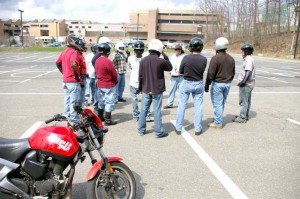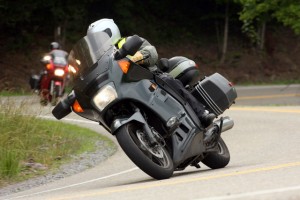By Steve Smith of RIDE-CT.com
 The ugly truth is that residing in New England areas means that most riders experience PMS, or parked motorcycle syndrome. Now it’s the time when many motorcyclists are coming off their winter hiatus and the excitement of getting the bike out for a ride on the first nice day may distract us from some things we should consider.
The ugly truth is that residing in New England areas means that most riders experience PMS, or parked motorcycle syndrome. Now it’s the time when many motorcyclists are coming off their winter hiatus and the excitement of getting the bike out for a ride on the first nice day may distract us from some things we should consider.
Student riders learn in rider education courses that a safe day of riding begins with preparation. This can be boiled down to three simple questions:
Are you ready?
Is you gear ready?
Is your motorcycle ready?
Preparing to take your first ride of the season is no different, but there are a few extra things to take into consideration. Considering these three questions, I thought that this would be a good opportunity to pass on some quick tips to keep you happy, healthy, and upright on your first ride of the season before you hit the streets.
Are we ready?
Mental preparation is very important. It has been a while since we’ve been riding. Take a few moments to shift your thinking away from the 4-wheeler and get into the “motorcyclist” frame of mind. Be more aware of your surroundings, road condition, and what other drivers are doing. Because they are smaller, motorcycles are more difficult to see. Compounding this is that driver are not yet used to looking for us out there. The Motorcycle Safety Foundation (MSF) has an online test to help improve visual perception.
End of winter road conditions need serious consideration. When temperatures are hovering around freezing small patches of black ice can lead to big problems. Until day and night temperatures are consistently above freezing be very cautious of places that look wet or damp. Be mindful of sand, especially in curves. Hopefully the roadways will be better when April showers and street departments do their thing. Be on the watch for potholes, which are plentiful this time of year.
Spring is a good time for a riding skills tune up. The Connecticut Rider Education Program (CONREP) has several course offerings for experienced riders to better prepare  themselves for the challenges of everyday riding and to be able to better deal with the surprises that can quickly ruin a great day of riding. Contact one of the CONREP training sites near near you for course offerings and availability.
themselves for the challenges of everyday riding and to be able to better deal with the surprises that can quickly ruin a great day of riding. Contact one of the CONREP training sites near near you for course offerings and availability.
The Experienced Rider Course (ERC) is a one-day course designed to improve rider skills in braking, evasive maneuvers, and turning. It provides the experienced motorcyclist with “street strategies” necessary for survival. This full day course consists of on-cycle instruction using your own street legal motorcycle. This is a great option as your first experience with a rider education class.
The Advanced Rider Course – Sportbike Techniques (ARC-ST) is another one-day course and may be taken by riders using any type of motorcycle. The course consists of 8.5 hours combined classroom and on-cycle instruction using your own street legal motorcycle.
If you have been riding on a permit and not quite ready to go to DMV to take your skills test, the Intermediate Rider Course (IRC) is for you. This course is for riders with some riding experience, and is designed to improve skills in braking, turning, and evasive maneuvers, and learn “street strategies” necessary for survival. The course consists of 10 hours combined classroom and on-cycle instruction. Participants must have a valid CT motorcycle permit and use their own street legal motorcycle.
Is our Motorcycle Ready?
Hopefully over the winter you performed basic maintenance and prepared your ride for spring. Is It is desirable to perform a visual and functional pre-ride check of your motorcycle before each ride to help ensure it will perform as expected. The Motorcycle Safety Foundation (MSF) “T-CLOCS” Pre-Ride Inspection Checklist” makes it easy to remember what to inspect. The acronym T-CLOCS, which stands for:
T – Tires & Wheels: Check tire pressure, condition, age and wear.
C – Controls: Verify all controls operate smoothly. Inspect for damaged cables and hoses.
L – Lights: Check battery condition so you are not left stranded.
O – Oil: And other fluids too.
C – Chassis: Check suspension and adjustment and condition of the chain, belt or shaft final drive.
S – Stands: A droopy side stand could make the first sharp left turn interesting.
Each year I hear stories of riders who find rodents and insects that nested somewhere in the nooks and crannies of a stored motorcycle. Spiders make nests in exhaust pipes and inlets. Field mice find their way into an airbox, and the combination of nest and nuts wreaks havoc on the air intake. I’ve seen them nested in places where they chewed on the wiring. In these cases the bike may start, but it can create increased risk to the rider if it remains undetected and something fails while riding.
Is our Gear Ready?
Once the bike is ready, let’s inspect our gear. Over time our gear does wear out. I’m no chemistry major, but I’ve been told that the expanded polystyrene (Styrofoam) used in the  impact absorbing liner of helmets will degrade just being exposed to air. Leaving the helmet on top of your fuel tank may expose it to gasoline fumes venting from the cap, and we all know will happen when gas comes in contact with expanded polystyrene. Sweat and skin oils can accelerate breakdown of a helmet’s padding, which can cause an improper fit.
impact absorbing liner of helmets will degrade just being exposed to air. Leaving the helmet on top of your fuel tank may expose it to gasoline fumes venting from the cap, and we all know will happen when gas comes in contact with expanded polystyrene. Sweat and skin oils can accelerate breakdown of a helmet’s padding, which can cause an improper fit.
Have the soles of your riding boot are worn smooth? If so, then you might not have the traction you need. I’ve had a foot slip on sand or other small road debris when pushing the bike backwards out of a parking space while sitting on it. When this happens it is very easy to have a leg go up in the air, lose balance, and the next moment finding yourself picking up the bike.
Early spring riding means cools temperature, especially if you take off in the morning. It is very easy to experience hypothermia and it is recommended to dress in layers to provide additional insulation. Layering has the added benefit of being able to remove layers if the mid day temps warm up. Electrically heated gear is another option to extend your riding season further. Becasue New England weather is unpredictable I like to carry rain gear on the bike that packs down small, or wear all weather gear. getting soaked from a surprise April rain can make you very uncomfortable, very quickly.
Now that we are ready, enjoy a great riding season.
 Ride CT & Ride New England Serving New England, NYC and The Hudson Valley!
Ride CT & Ride New England Serving New England, NYC and The Hudson Valley!


